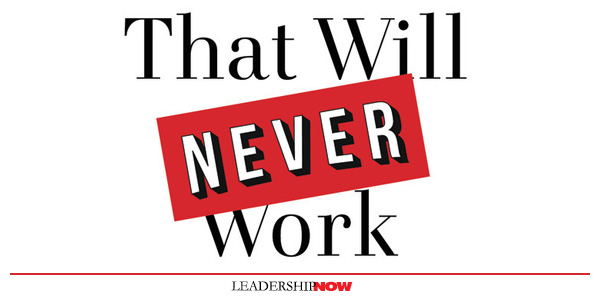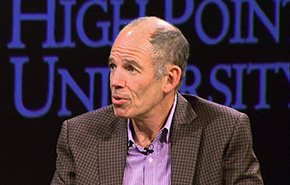 |
 |
09.24.19

“That Will Never Work”
THE STORY GOES that the idea for Netflix came to Reed Hastings after he was hit with a $40 late fee when he returned his rental of Apollo 13 to Blockbuster. Annoyed, he thought, “What if there were no late fees?” And wham, the idea for Netflix was born. Of course, we like stories like that. It’s neat and clean, but in this case, it’s not true. It’s useful though, and it captures in a paragraph the essence of what Netflix is all about. Marc Randolph, Netflix’s co-founder, and first CEO says it’s emotionally true. “Reed’s oft-repeated origin story,” he says, “is branding at its finest, and I don’t begrudge him for it at all.” The real story is longer. While it is messy and complicated, it is much more exciting. Marc Randolph shares it all in That Will Never Work: The Birth of Netflix and the Amazing Life of an Idea. I read a lot of business books, and I can say this is one of the best you’ll ever read on starting and growing a business—the emotions, the triumphs, the failures and the lessons learned. The story is a well-told page-turner. Briefly, the real story is that while carpooling with Hastings to jobs that would soon be redundant due to a merger, Randolph would pitch ideas to him in search of the next act. After a slew of ideas like customized shampoo, dog food, and baseball bats, Randolph hit upon renting VHS tapes online. But, among other things, the costs for acquisition and shipping were too high, so it was ruled out. That is until they learned about an emerging technology—DVDs. Then the game was on. DVDs were cheaper and lighter, but would they be shipped safely. They tested it by mailing a CD in a greeting card envelope to Hastings. It worked, and they had their idea. And people said, “That will never work.” When you start a company, what you’re really doing is getting other people to latch on to an idea. You have to convince your future employees, investors, business partners, and board members that your idea is worth spending money, reputation, and time on. Randolph risked his time and Hastings risked his money. Now the work began. I needed to come up with something approaching a business plan. Notice that I used the word “approaching.” I never intended to get there. Most business plans are a complete waste of time. They become obsolete the minute the business starts and you realize how wildly off the mark you were with your expectations. So the trick is to take your idea and set it on a collision course with reality as soon as possible. Randolph takes us through the whole process from idea to launch day. Any entrepreneur will relate to the journey, and any would-be entrepreneur will find it enlightening. He candidly writes about pitching the idea to investors (what it was like to take a check for 1.9 million dollars to the bank), finding and getting talent, setting up an office, building the basics, building an inventory and the mailer, and building a website. And creating an innovative culture: Real innovation comes not from top-down pronouncements and narrowly defined tasks. It comes from hiring innovators focused on the big picture who can orient themselves within a problem and solve it without having their hand held the whole time. We call it loosely coupled but tightly aligned. He adds this: Most companies end up building a system to protect themselves from people who lack judgment. And that only ends up frustrating the people who have it. Launch Day: April 14, 1998 There are a great many stages in the life cycle of a startup. But a tectonic shift happens on launch day. Before you go live, you’re in the dreamy zone of planning and forecasts: your efforts are provisional. For better and for worse, things never go as planned. And Randolph gives an account of all of it—the possible acquisition of Netflix by Amazon, the potential buyout by Blockbuster, the rethinking of the business model, the ups and downs. Great stories with lessons in them all. My favorite chapter was, I’m Losing Faith in You. After about 18 months in, Hastings comes to him and tells him that he’s losing faith in his ability to run the company alone. He suggests (really more of an ultimatum) that he come in as CEO and Randolph become president. He writes, “Radical honesty is great, until it’s aimed at you.” Randolph had to take a look at himself—his strengths and weaknesses, his goals and motivations—and decide what was best for the company. It takes a tremendous amount of humility to do that and to agree to what Hastings was asking. I realized that there were really two dreams, and I might need to sacrifice one of them to ensure that the other came true. And that was Hastings strength. Hastings became CEO and Randolph became the president in 1998. His self-knowledge made is easier for him to know when it was time to go as he eventually did in 2003 not long after Netflix went public. He realized that he liked building things more than the finished product. In the end he writes, “I missed the late nights and early mornings, the lawn chairs and card tables. I missed the feeling of all hands on deck, and the expectation that every day you’d be working on a problem that wasn’t strictly tied to your job description.”  Randolph is conversational and generous to others throughout. There is a lot of experience-based wisdom in this book. Here are a few more insights: We were always trying to avoid one of the number one pitfalls of startup entrepreneurship: building imaginary castles in your mind, meticulously designed, complete with turrets, drawbridges, moats. Overplanning and overdesigning is often just overthinking—or just plain old procrastination. When it comes to ideas, it’s more efficient to test ten bad ones than spend days trying to come up with something perfect. 
Posted by Michael McKinney at 04:35 PM
|
BUILD YOUR KNOWLEDGE
 

How to Do Your Start-Up Right STRAIGHT TALK FOR START-UPS 
Grow Your Leadership Skills NEW AND UPCOMING LEADERSHIP BOOKS 
Leadership Minute BITE-SIZE CONCEPTS YOU CAN CHEW ON 
Classic Leadership Books BOOKS TO READ BEFORE YOU LEAD |